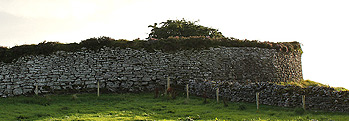Ring Forts
Irish and Celtic myths and legends, Irish folklore, Irish fairy tales and More Irish Tales and Legends
Ring Forts of Ireland

Irish ring forts are some of the most common ancient monuments remaining in Ireland today, once homes to many different clans and families, there are estimated to be over fifty thousand of these fortifications scattered in every corner of the country. Modern research is beginning to indicate that not all of them, or even the majority of them, were simple circular stone walls. They might also have been tower halls, like Scottish brochs, with great inward-leaning walls and a roof overhead, supported by a roof-tree.
They go by many names in Irish, such as rath, caiseal or castle, cathair or settlement, dún or fortress, and lios. Some date back to the bronze age but it is believed that most were constructed during the iron age, remaining in use until about 800 AD. They may have had earthen baks built up around them, complete with a wooden wall above that, lending further credence to the idea that these were closer to brochs in their original shape, although they might have been used as cattle pens after they collapsed.
Underneath and around these forts could be found souterrains, low tunnels and crawlspaces which enabled the inhabitants to escape in case invaders made it inside. These led to chambers or caves and to escape routes into the nearby wilderness. It is no coincidence that there were mostly added around the time of the worst of the Viking depredations!
Ring forts can be quite small, in size, or up to a hundred meter across, and their former inhabitants have left behind items associated with every human endeavour, from craftsmanship to trade to raising a family.
The idea that many of these ring forts might have been brochs or tower halls is founded upon several observations.

To begin with, a ruined broch and an Irish ring fort are almost identical, right down to the hollow walls in several examples - a feature not usually associated with defensive walls. Almost all of the Scottish brochs look like supposed ring forts now, besides the most remote examples, because locals carted away their plentiful unmortared drystone and used it for field walls, farmhouses and other buildings. It is reasonable to assume a similar fate befell Irish halls.
The idea that they were used as livestock pens, at least initially, runs into trouble because it would be almost impossible to fit an animal wider than a human being into their single defensible entryway, unless the Irish had developed some sort of tackle and winch apparatus to haul live cattle over and back in the mornings and evenings. In terms of defence, the low, uncrenellated walls would have difficulty keeping out a determined wolf, let alone armed raiders, of which there was no shortage even before the Vikings arrived.
Although we look at ring forts today and see nice, neat, levelled walls, most of those were badly reconstructed in the 19th century by enthusiasts with no clear idea what they were doing.
Many ring forts have a central stone platform which is usually listed as "building" despite being only a meter or two across. Rather tight quarters for a building, but an excellent foundation for the central pillar or roof tree of a tower hall! If one wanted to build a hearthstone there are many better and easier ways of doing it than hauling in and embedding a massive slab of rock.
These broch-ring-forts could easily have been designed with internal wooden stairs and walkways, which would not have survived either their demise or the intervening millennia and centuries. And then we have the continued references to towers in Irish mythology, such as at Tory Island, Túr na Rí, the Tower of the king.
Any absences of mention during later periods is comparable to the almost total lack of historical references we have to Scottish brochs, to the extent that researchers don't know whether they were built for defensive purposes, as status symbols, or for some other reason! Also the distribution patterns and clusters of brochs are similar to those of Irish ring forts.
Irish round towers, first raised in the eighth century, are wonderful examples of the architectural skill that building brochs would have imparted.
Perhaps Ireland was once a mysterious isle of dark and ancient primordial forests, wreathed in mist and mystery, with ancient towers rising here and there among the trackless trees, a land of druid-princes and strange were-wyrms in the deep places, clan rivalries to match anything in Game of Thrones, a place that could well have produced people who created the astonishing metalwork they left behind!
Ring Forts of Ireland
The royal ringfort of Grianán Ailigh was known as the father of every building in Ireland by the Annals of the Four Masters, who also claimed it was first built in the year 1500 BC, in the time of the Tuatha Dé Danann! A mighty place of strength it is and was and may always be, one of the few locations in Ireland correctly marked on a ... [more]
There are tens of thousands of round stone forts in Ireland, some say as many as fifty thousand, if you can believe it, and one of the finest examples we have is at Kilcashel in County Mayo, which comes from the Irish Coill an Chaisil, the woods of the stone fort. Almost perfectly circular in construction, with thick walls two broad men could walk ... [more]
Dún Aonghasa means "the Fort of Aonghasa", and remains one of the most impressive ancient monuments in Ireland, Europe or the world. Perched on the edge of a high and jagged cliff with the grey-green waters of the Atlantic battering below, it gained its name from its original builders, who were called the Fir Bolg, some of the ... [more]







